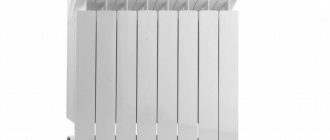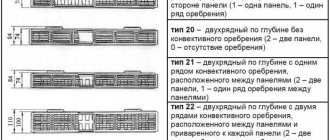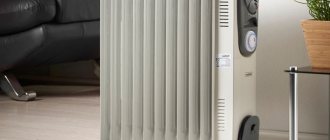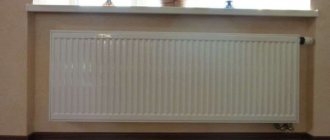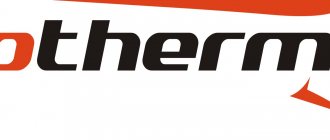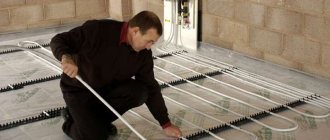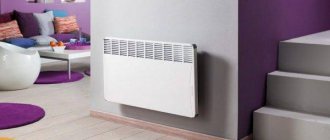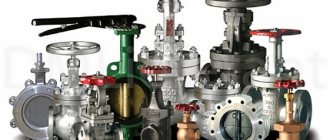Heating a country house or apartment is one of the issues addressed by owners who are renovating an old home or arranging a new one. The comfort, coziness and even health of all household members depends on the efficiency of the heating system.
Therefore, it is so important to choose correctly all its elements, the main ones being radiators.
Steel or aluminum radiators are most often installed; we will look at their design differences, advantages and disadvantages, and also determine which is better suited for installation in an apartment and which for installation in a private house.
Aluminum radiator design
The aluminum heating radiator consists of separate sections connected to each other at the top and bottom. Inside each section there is a vertical channel for the flow of water or coolant.
On the sides of each section there are “feathers” - vertical plates, with the help of which the metal gives off heat. Most aluminum radiators have cut-offs - plates located on top that remove heated air indoors (see figure).
Aluminum radiator air cut-offs.
Rating of the best cast iron heating radiators for apartments
Ratings often help to correctly select the best model. They are compiled taking into account consumer reviews. Below is a rating of the quality of cast iron heating radiators, which includes models of different price categories.
VIADRUS STYL 500/130
The model has a modern design. Withstands heating of the coolant in the heating system up to 115 oC. The maximum operating pressure is 12 bar, and the permissible pressure during pressure testing is 18 bar. The section holds 800 ml of coolant.
A Czech-made model costs about 27 thousand rubles
KONNER MODERN 500
The radiator is capable of operating in a heating system with standard parameters. Cast iron walls can withstand pressure of 12 bar. One section holds 900 ml of coolant. Due to the thin walls, rapid heating and heat transfer occurs. A device with 12 sections is capable of heating a room up to 27 m2.
The German model was produced at a Chinese factory, costs about 4 thousand rubles
STI NOVA 500
The radiator is capable of operating in a heating system where the coolant temperature reaches 150 °C and the short-term pressure reaches 18 bar. Thermal power reaches 1200 W, which allows you to heat a room up to 20 m2.
The popular model costs 7.5 thousand rubles and is considered a bestseller
GuRaTec Apollo 765/05
A stylish solution for lovers of rarities. The radiators are equipped with legs, which allows them to be installed on the floor without the need for mandatory hanging. This option is convenient for rooms with weak walls. The product consists of 5 sections, each of which holds 210 ml of coolant. Maximum power – 725 W.
Models are copies of French products
MZOO MS-140M-05
The standard model consists of 7 sections, but you can add any number of them if desired. The design remains Soviet-style. Due to the budget cost, the radiator can be installed in a non-residential area or covered with a decorative screen.
A conventional battery according to the Soviet standard is still in demand
How a steel radiator is made
Steel panel radiator is a non-separable design. Its heating element consists of two horizontal tubes, between which there are vertical ones through which water circulates.
Between the tubes there is a Z-shaped or U-shaped plate (casing) along the entire length of the radiator. It warms up from the element and gives off heat to the air. This entire structure is enclosed in a steel casing, in the upper part of which there is a grille for air circulation.
Steel radiators come in three main classes: 11, 22, 33. They differ in the number of heating circuits and casings:
- 11 – one circuit, one casing;
- 22 – two circuits, two casings;
- 33 – three circuits, three casings.
Types of steel panel radiators.
Panel steel
The most budget-friendly type of heaters has high heat transfer characteristics, a compact size and will decorate any interior. The types differ in connection types, but the radiator itself is solid and is not divided into sections, like aluminum. The panel type is narrower than the sectional one. This design is better for private houses with large windows, since due to their structure, steel panel heaters can interrupt drafts or cold from a large window.
Advantages of steel panel batteries:
- low price;
- light weight and compact dimensions;
- long service life;
- good efficiency factor.
Disadvantages of steel panel batteries:
- not too harmonious appearance, which may stand out from the interior design;
- should be flushed every three years to prevent blockages;
- the need for constant filling does not exclude the appearance of rust, which will lead to rapid wear of the product.
The whole difference is in thickness
Aluminum radiators have thicker feathers and walls. Moreover, it does not particularly affect the heating efficiency, since this metal has good thermal conductivity. But due to the thickness, the strength of the heating device increases, which makes it possible to work with coolants at high temperatures and under high pressure.
Steel radiators are made of fairly thin metal. This is done in order to compensate for the low thermal conductivity of steel. The small thickness of the walls of the tubes and plates makes it possible to effectively heat the room, but has a negative impact on strength.
Who is warmer?
The efficiency of aluminum radiators is higher than that of steel, but only on average. If you compare a regular aluminum battery and a class 33 steel radiator, the latter will be able to give off more heat. But it is worth considering the type of radiator connection and the water flow rate.
Example
If you have a class 33 steel radiator installed and the water flow rate is low, it will work efficiently. That is, it will take maximum heat from the water. If a single-pipe connection is used, this is bad - cooled water will enter the next heating device and it will not heat.
If a steel radiator of class 11 or 22 is installed, then they will also heat well, but will not have time to cool the water.
It is impossible to say exactly how much more heat transfer from an aluminum radiator is greater than that of a steel radiator - a lot depends on the design and thickness of the metal. On the one hand, the thermal conductivity of steel is on average 3.5-4.5 times worse than that of aluminum. But the thickness of the steel radiator tubes is also less, which can compensate for this difference.
What kind of water do radiators like?
Aluminum is very sensitive to water quality. With increased acidity or alkalinity, gas is formed in it, which creates an air lock and impairs the heating efficiency. you have to periodically remove air from the battery manually or using a Mayevsky tap.
In addition, aluminum can react with chemicals contained in water or poor-quality coolant. It begins to corrode, which does not happen with steel radiators.
Steel is a chemically inert metal; it does not react with coolants and chemicals dissolved in water. The only danger is corrosion, which can form while the water is drained from the heating system. But good manufacturers cover the internal channels with an anti-corrosion coating or paint.
Copper batteries are the best
Click on photo to enlarge
For most of our compatriots, copper radiators are unaffordable. If not for the price, they would be the most in demand.
Which radiator has better heat transfer? At the copper one!
The thermal conductivity of copper is significantly higher than that of steel, cast iron and aluminum. This means that copper radiators are the most efficient heating devices.
They perfectly withstand water hammer and, importantly, are not at all afraid of chemical impurities in the coolant.
An oxide film forms on the inner surface of the sections, which reliably protects the metal from destruction. They can be used in both centralized and autonomous heating systems of any type.
Operation and Maintenance
Steel radiators are produced in the form of finished panels. If the heating battery power is calculated incorrectly, you will have to add a new one.
With an aluminum radiator, everything is simpler - if desired, you can add one or more sections, or remove unnecessary ones. You can do this yourself.
The service life of aluminum radiators depends significantly on the manufacturer and model range. The cheapest ones will begin to leak after 5 years, or will crack with a slight water hammer (see photo). And expensive models can last 20 years or more.
An aluminum radiator burst due to water hammer.
It's more difficult with steel radiators. By definition, they cannot be particularly durable - thick metal will worsen their thermal conductivity. Therefore, they are afraid of high pressure and quickly wear out when it changes.
But if the system has stable operating pressure and there are no water hammers or surges, then a steel panel radiator can last 15 years. In addition, in case of problems, it can be “patched up”. This is much easier to do than repairing aluminum.
As for special care, neither steel nor aluminum require it. Unless you need to wipe them from dust, which is easier to do with a steel radiator.
Features of bimetallic batteries
To level out the shortcomings of aluminum, engineers have developed so-called bimetallic devices. They consist of a steel core with high corrosion resistance and an outer aluminum shell with a powder protective and decorative coating. This combination gives the main advantage of bimetallic radiators over aluminum ones: optimal thermal conductivity and low thermal inertia.
What is the difference between aluminum radiators and bimetallic ones? The former are sensitive to the composition and temperature of the water, pressure and design. The disadvantages of the second type:
- less clearance inside, which increases the likelihood of blockages;
- heat transfer is 20% lower due to the lower thermal conductivity of steel;
- higher prices for bimetallic heating batteries - on average by 15-40%;
- if oxygen enters the system, active corrosion and destruction of the metal begins;
- In low-quality products, areas of local overheating appear in the contact zones of aluminum and steel, which leads to deterioration in consumer properties and damage to devices.
Regarding the complexity of installation, reviews of bimetallic and aluminum sectional radiators are similar in that special care is required with the latter. Aluminum is a soft metal and can be easily deformed
What is required for installation: accurate calculation, a set of keys and some tools (screwdriver, pliers, drill), shaped elements. The battery kit is assembled, the necessary taps and nipples are installed. Marking of fastening locations and their installation are carried out. The device is placed on the brackets, checked with a level, threads are cut on the risers, connections are made and appropriate sealing is carried out. The cost of services of professional plumbers in Moscow starts from 1,500 rubles.
From a design point of view, both types fit perfectly into modern interiors, and a large selection of colors allows you to do without camouflage screens and screensavers. Thus, the answer to the question “which radiators are better - aluminum or bimetallic?” lies within the scope of their application. For autonomous systems the former are used, for centralized systems the latter are used. And since they work on the principle of convection and significantly dry the air, it is recommended to purchase humidifiers.
Where is steel better and where is aluminum?
Which heating radiators are better for a private house, and which for an apartment? The answer to this question is simple.
In a private home, you can monitor the quality of water or coolant. In an individual heating system, there are no water hammers or large pressure drops. A steel radiator in a private home will last a long time.
In apartments with a central heating system, it is impossible to check the water quality. Changes in temperature and pressure in the central heating system are not uncommon. So using steel radiators is quite risky - it’s better to fork out money and install aluminum ones.
Steel radiators are, on average, cheaper than aluminum ones. Of course, among both types there are premium models from well-known manufacturers, which differ in design (see photo) and are more expensive than usual. But if we take the middle class, then steel costs less.
Custom aluminum radiator.
Non-standard steel radiator.
The best manufacturers of cast iron radiators
Batteries from domestic and foreign manufacturers are available on the heating equipment market. In terms of availability, it is optimal to consider the first option.
Classic domestic radiators MS-140 are still produced by the Nizhny Tagil plant
Among the domestic manufacturers, the following companies can be distinguished:
- The Cheboksary plant produces its products under the name CHE.RAD. Batteries are produced with two and three channels with a depth of 102-120 mm. Its popularity is due to its modern design and the absence of inaccessible areas where dust collects. In appearance, the products are similar to modern aluminum radiators.
- The Lyubokhonsky plant produces batteries with a refined wall 85 mm deep. They are capable of operating in heating where the coolant pressure does not exceed 12 atmospheres. In appearance, the products compete well with imported analogues.
- The Nizhny Tagil plant will satisfy the needs of classics lovers. The manufacturer produces products of the MS-140 brand according to the Soviet standard, but there are also new models of the improved T-90 design.
True German quality is reflected in Guratec Apollo radiators.
Products for heating systems from foreign manufacturers are up to 4 times overpriced, but demand for them is increasing. Popular brands include:
- The products of the Turkish company Demir Dokum have an exquisite design in a “retro” style. Heating with Turkish radiators looks elegant even in luxury mansions.
- The German manufacturer Guratec produces expensive products, but the quality and design are excellent. The cast iron surface of the batteries is covered with a layer of special paint, which is difficult to even scratch.
Heating from imported batteries will be expensive. The cost of one product can vary from 36 to 130 thousand rubles.
Steel and aluminum radiators, comparison (table)
| Parameter | Steel | Aluminum |
| Efficiency | — | + |
| Number of species | + | — |
| Coolant requirements | + | — |
| Possibility of improvement | — | + |
| Life time | +/- | + |
| Ease of use | + | — |
| Warm-up and cool-down speed | + | + |
| Design solutions | +/- | +/- |
| Price | + | — |
As you can see, it is impossible to say for sure which batteries are better, aluminum or steel. both options have their pros and cons. So you need to choose one or another type of radiator depending on your needs.
We hope the article was useful to you. You can leave your opinions and questions in the comments. Don't forget to share the post with your friends!
Loading…
